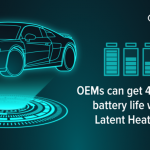Batteries that don’t catch fire: How OEMs can guard against thermal runaway in electric vehicles
With increasing concern around the issue of environmental sustainability and the need to reduce the use of fossil fuels, the electric and hybrid vehicle market is experiencing rapid commercial growth. Electric vehicles are part of the sustainability solution and adoption will continue to grow as consumers in many countries switch from conventional fuel vehicles to Electric Vehicles (EVs).
Nonetheless, some consumers are reluctant to purchase an EV with lithium-ion- batteries due to safety concerns. Lithium-ion batteries have a narrow operating temperature range between 10°C- 55°C. The safety of the battery pack necessitates that the lithium-ion cells remain in this temperature range.
Individual lithium-ion cells in a battery pack can fail catastrophically for many reasons including deformation due to accident, overcharging of the cells, excessive temperature, or degradation of electrodes over time. When one cell fails it produces intense heat leading to fire and explosion. Thermal runaway occurs when the high temperature and explosive gases from failure of one cell propagate to adjacent cells and ultimately the entire battery pack. Catastrophic thermal runaway is extremely dangerous and can lead to serious injury or death.
What is Thermal Runaway?
Lithium-ion cells contain a flammable liquid electrolyte. When a short circuit in a cell is caused by deformation, overcharging, overheating, or degradation of the electrodes, the electrolyte will combust causing extremely high temperatures (up to 1,000°C) and pressures, leading to explosive ejecta that can propagate thermal runaway to adjacent cells.
Solutions to thermal runway
A proven way to mitigate the risk of thermal runaway is the XTS system developed by Latent Heat Solutions (LHS). In the event of a cell failure, the XTS system quickly reduces the temperature and pressure at that cell and quenches the ejecta, preventing propagation to adjacent cells. In addition, during normal operation of the battery pack, the XTS system provides passive thermal management by energy absorption and heat dissipation, enabling lower and more consistent temperatures from cell to cell, thus increasing pack life. LHS products are an effective, simple, and economical solution for the prevention of thermal runaway as well as thermal management of high-power lithium-ion battery applications.
These materials are specifically designed to prevent thermal runaway, maintain homogenous temperatures across cells and reduce battery overheating due to fast charging or discharging. LHS materials are proven to prevent thermal runaway and increase battery life.
As concern for the environment rises around the world, the market for EV cars, buses, and motorcycles that utilize lithium-ion batteries will grow significantly. In order to provide comfort to consumers and increase the rate of adoption of these vehicles, it is critical that the battery packs are safe and reliable. LHS provides systems and materials to OEMs that make this possible
To use LHS Materials in your EV battery and for any questions, please connect Ashutosh at ashutosh@quanzen.com





